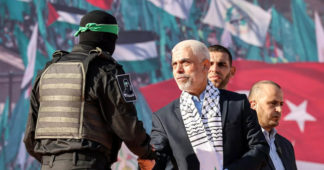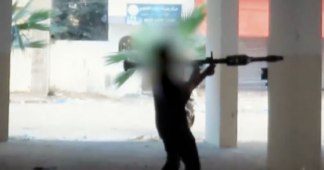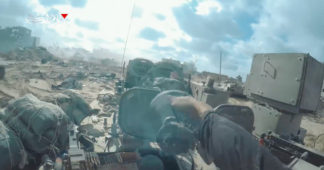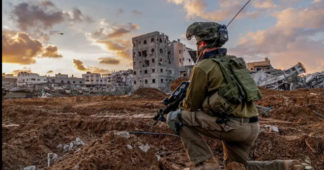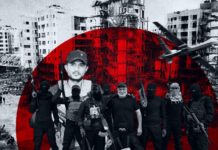Tel Aviv has handed Gaza’s warfront to death squads and collaborators, using the cover of a ceasefire to wage a proxy campaign against the resistance.
Robert Inlakesh
Oct 21, 2025
With the already violated ceasefire in place, and Israeli occupation forces implementing a phased withdrawal, Gaza remains under siege, this time through Tel Aviv’s use of armed collaborator militias.
Drawing on tactics refined in Syria, these death squads have been unleashed to assassinate resistance figures, sow chaos, and undermine what remains of the Hamas-led administration.
Three proxy groups backed by Tel Aviv have since escalated their military campaigns against Gaza’s security forces and society. These militias of collaborator death squads have been used to stir chaos on direct orders of the Israeli army, seeking to establish bases of control in the portions of the territory that Israel has yet to withdraw from.
Upon the cessation of hostilities between the Israeli military and Palestinian resistance factions, at least 7,000 security personnel affiliated with the Hamas-led civil administration took to the streets of Gaza to establish law and order. Yet, almost immediately, they were confronted with ambushes, and armed clashes broke out in a number of areas of the territory.
In particular, the armed clashes in northern Gaza have received the most attention in the media, with Israeli and a handful of Palestinian Authority (PA) aligned personalities attempting to sell the situation as a “civil war.”
Collaborator militias exploit the Gaza ceasefire
Amid the chaos, the son of senior Hamas leader Bassem Naim was shot in the head by proxy forces. Mohammed Imad Aqel, son of a prominent Qassam Brigades commander, was murdered by members of the Doghmush clan. And Saleh al-Jaafarawi, a prominent journalist, was kidnapped, tortured, and shot dead at point-blank range.
At the beginning of October, in Khan Yunis, the Majayda family reportedly collaborated with Hossam al-Astal under Israeli air cover, launching attacks on security positions – a key example of Tel Aviv’s use of clan structures to advance its proxy war strategy.
Israeli researcher Or Fialkov noted:
“The Majaydeh clan from Khan Yunis – which fought Hamas a week ago – announces it has disarmed. The clan, which received assistance from the Israeli army in airstrikes against Hamas members, said it has handed over its weapons to Hamas. Hamas is settling scores across the strip and showing everyone who is in charge.”
To counter the threat posed by these armed collaborators, Hamas formed two new specialized units. The first, Sahm (Arrow) Forces, is comprised of officers from the civil security services. The second, the Resistance Security Force (Amn al-Muqawamah), includes fighters from Hamas’s military wing, as well as those from the Popular Front for the Liberation of Palestine (PFLP), Palestinian Islamic Jihad (PIJ), Fatah al-Intifada, and other factions.
A senior security source in northern Gaza tells The Cradle that a document containing a hit list was discovered during a raid on a collaborator’s hideout. Although the document itself could not be shared, the source claims it noted that Israel’s “goal is to create chaos, to carry out assassinations, allow for lawlessness, and to fight the resistance through its collaborators.”
This account was reinforced in a KAN News interview, in which the leader of one collaborator militia confirmed that the Israeli army is providing his forces with security support and authorization to operate beyond the so-called Yellow Line. Roughly 54–58 percent of Gaza is still under the occupation army’s control.
US advisors recently informed Axios that Washington is working on an Israeli-backed plan to create pathways for Palestinians opposed to Hamas to live outside of Israel’s Yellow Line. To this effect, the Israeli military is currently marking this line by installing cement blocks and security equipment to demarcate its boundaries.
According to Israel Hayom, the American-Israeli plan seeks to use Gaza reconstruction funds to begin rebuilding hospitals, schools, and homes inside the territory that is jointly controlled by the Israeli army and its ISIS-linked proxy groups.
Under this scheme, Palestinians will be presented with the choice to live under Hamas along the coast or inside the newly constructed areas. It appears as if a proposed multinational military force will also be used to help implement such a model.
Despite this, the collaborator groups currently operating there do not enjoy popular support, and Israel is continuing to demolish the remaining civilian infrastructure located there. Meanwhile, all the major families, segments of whom began fighting Gaza’s security forces, have issued statements aligning themselves with Hamas and against any collaborators in their midst.
The Ramallah-based PA has also expressed its interest in vying for power in the Gaza Strip, yet Israel has at least publicly rejected this idea over fears that this will put it in a stronger position to demand a Palestinian State. Nevertheless, the PA has been part of a propaganda campaign designed to delegitimize Hamas as a political entity in Gaza and accuses it of indiscriminately targeting its opponents.
Tel Aviv retools death squads as ‘Popular Forces’
Throughout the two-year Israeli war on Gaza, humanitarian aid convoys were routinely looted in the southern enclave, triggering food shortages and creating a booming black market. The looting initially involved armed clans and petty criminals who charged extortionate bribes for aid access. But following the 6 May invasion of Rafah, the phenomenon transformed into a more coordinated enterprise.
That evolution gave rise to the Abu Shabab militia, a gang led by convicted drug trafficker Yasser Abu Shabab, who has long-standing links to ISIS affiliates in Sinai. His fighters, many from the Bedouin Tarabin clan, have ties stretching from Israeli-occupied Bir al-Saba (Beersheba) to Egypt’s Sinai Peninsula.
A Hamas official familiar with the file on drug trafficking tells The Cradle:
“These individuals were known to routinely cross into the Sinai and maintained close ties to extremists. These criminal elements were also tied to the Ansar Bait al-Maqdis group [ISIS in the Sinai] and later Wilayat Sinai that came after it. These people do not have a coherent ideology and will shift over time, they are criminals, which is why they are also involved in activities like drug smuggling, and their connections come through familial ties.”
Following the surface of footage of these militants driving around in SUVs bearing Sharjah license plates registered in the UAE, sources belonging to Al-Akhbar claimed that Emirati intelligence has been cooperating with these militia forces.
A month prior to the introduction of the Abu Shabab aid looting gang to the scene, Israel’s top human rights group B’Tselem had issued a report accusing Tel Aviv of “manufacturing famine” in the enclave. A later investigation conducted by Sky News revealed that while most Palestinians were suffering a severe food shortage, the Abu Shabab gangs were living a life of luxury, with an abundance of stolen aid, along with vehicles and weapons supplied by Israel.
This group, despite becoming infamous throughout Gaza for stealing aid from humanitarian organizations, demanding a $4,000 bribe fee for each truck, was soon to be destined for a task much more pernicious.
In November 2024, the Israelis saw that it was time to give their aid looting cadres a facelift, as the Washington Post interviewed Yasser Abu Shabab himself, who is portrayed as a criminal by necessity and claims that “Hamas has left us with nothing.”
Amid the January ceasefire, the gang resurfaced as the “Popular Forces,” now dressed in Israeli tactical gear and openly operating with occupation military backing.
The Wall Street Journal (WSJ) even published an op-ed supposedly authored by Abu Shabab titled “Gazans are finished with Hamas.” Local sources confirm to The Cradle that the militia leader is illiterate and could not have authored a piece in Arabic, let alone English.
By June, former Israeli minister Avigdor Lieberman publicly accused Israeli Prime Minister Benjamin Netanyahu of backing ISIS-linked militias in Gaza. Netanyahu not only confirmed the collaboration – but defended it. Then, in September, Haaretz reported that Popular Forces militias were receiving direct orders from the Israeli army and Shin Bet.
Israel’s proxy model expands across Gaza’s clans
As the Israeli military was experiencing a manpower crisis, recently struggling to recruit 60,000 soldiers for operation “Gideon’s Chariots 2” to occupy Gaza City, it made the decision to expand this proxy militia strategy.
In August, Israel worked alongside Hossam al-Astal, a former member of the PA’s Preventive Security Forces (PSF), to form the “Counterterrorism Strike Force” (CSF) that would run operations in the Khan Yunis area of Gaza. Astal, according to two security sources speaking to The Cradle, had long been suspected of holding ties with the Israeli Shin Bet.
Alongside the CSF, new groups like the “People’s Army Northern Forces” (PANF) have emerged in Jabalia and Beit Lahia. Led by Ashraf Mansi, who had been openly praised by Abu Shabab. The PANF consists of drug dealers and ex-Jaish al-Islam fighters, some linked to ISIS. The group even held an armed parade after the ceasefire, before engaging in clashes with Gaza’s Radaa security unit, which captured several of its fighters.
In Gaza City, the Doghmush clan launched a violent campaign to assert control over parts of the north. It raided civilian homes, looted properties, and allegedly murdered prominent figures. After the killing of journalist Saleh al-Jaafarawi, Hamas cracked down, arresting dozens and killing up to 40 armed members of the clan.
The family has long developed a negative image throughout Gaza, due to actions committed by certain elements within it, dating back decades to before the Intifada, when individuals from the Doghmush family would steal cars from Israeli-held territory. The Mukhtar of the clan was assassinated by Israel back in 2023, and according to local reports, groups of men within the family have been arming themselves throughout the war.
Soon after tensions escalated, especially surrounding the murder of Jaafarawi and the clashes that ensued on Sunday, the Doghmush family released a statement disavowing collaborators and “transgressors,” reminding the public of how many members of the clan were killed by Israel. It is still unclear whether the militants from the Doghmush family were working alongside the PANF militia or were operating as a solo force motivated by control of territory.
However, the Doghmush clan represents a more complex case. While certain elements have openly collaborated with Israeli intelligence, others have refused such alliances. The clan is divided, with some fighting Hamas for over two decades, and others remaining within resistance ranks.
Reports have also linked segments of the clan to Dahlan networks and Emirati funding, alongside Salafi militant ties.
Salafist group Jaish al-Islam, once led by Mumtaz Doghmush, was responsible for the 2006 kidnapping of Israeli soldier Gilad Shalit. Initially allied with Hamas, the group later turned against it, pledging allegiance to Al-Qaeda and even kidnapping two Fox News journalists.
Hamas has long battled Salafist militants inside Gaza, including Jund Allah and the Sheikh Omar Hadid Brigade. In 2009, it crushed Jund Allah in Rafah after the group attempted to declare an “Islamic emirate.” By 2015, the Omar Hadid Brigade was dismantled. In 2018, ISIS formally declared war on Hamas.
Today, Israel’s proxy fighters recycle the same Salafi justifications. Popular Forces fighter Ghassan Duhine, for instance, cited ISIS fatwas branding Hamas as apostates who deserve death.
But despite Israeli efforts to fragment Gaza’s internal cohesion, many families and clans have pushed back. The Majayda family has denounced collaborators, as have key members of the Tarabin clan.
“Israel hoped to install these agents to run concentration camps for Palestinians, like they planned in Rafah with the Gaza Humanitarian Foundation,” a senior Hamas official tells The Cradle. “But our people can see through all of these conspiracies.”
While Tel Aviv pretends its military campaign is on pause, the facts on the ground reveal otherwise. Israel has outsourced the next phase of its war to collaborators, criminals, and extremists – executing its war objectives through mercenaries while claiming plausible deniability. It is a page taken straight from its playbook in Syria, now recycled in Gaza with deadly effect.
.
We remind our readers that publication of articles on our site does not mean that we agree with what is written. Our policy is to publish anything which we consider of interest, so as to assist our readers in forming their opinions. Sometimes we even publish articles with which we totally disagree, since we believe it is important for our readers to be informed on as wide a spectrum of views as possible.

